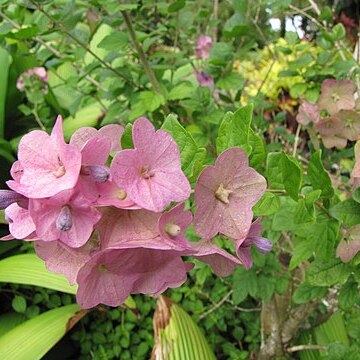Leaves deciduous, lamina up to 11 × 6.5 cm, variable in shape sometimes on the same branch, elliptic-oblong, obovate to oblanceolate or lanceolate, acute at the apex, cuneate to narrowly rounded at the base, entire or coarsely serrate-dentate to lobed with 1–3(7) teeth or lobes on each in the upper 1/3 to 1/2, ± pubescent on both surfaces, usually sparsely so or hairs mainly on the nerves beneath, blades chartaceous, the nerves ± prominent beneath; petiole up to 8 mm long.
Corolla pale to dark blue, lilac, pinkish, purple or purplish-brown (?); tube 2.5–4 mm long, with short gland-tipped hairs distally; limb 16.5–18 mm long, narrow, with short gland-tipped hairs on the lower surface towards the base and densely villous towards the apex and on the lateral lobes; labellum 8.5–11 mm long, flabellate and irregularly narrowly laciniate; lateral lobes c. 4 × 3.5 mm, rounded at the top, entire.
Calyx green, grey-green to pinkish-green, c. 1.5 cm in diameter, rotate, shallowly 5-lobed, the lobes broadly ovate-triangular, densely pubescent and gland-dotted outside, fruiting calyx brownish, very accrescent, 2.5–4 cm in diameter, rotate-patelliform, with a shallowly to distinctly 5-lobed limb, chartaceous-coriaceous, venose with reticulation prominent.
Fruit c. 6 mm long, turbinate-obconical or somewhat obpyramidal, ± flat at the top with 4 horn-like appendages arranged in the shape of a cross, the horns 2–3(4)-crested, densely villous to shortly hispidulous in the upper half, glabrous below.
Cymes axillary or crowded at apices of shoots, 1–3-flowered, up to 6.5 cm long; peduncles 2.5–3 cm long; bracts c. 4.5 mm long and 6–8 mm broad, broadly ovate; pedicels villous.
Filaments c. 4 cm long, densely covered with short gland-tipped hairs towards the base and provided with a tuft of small white obtuse scales near the insertion.
Ovary densely villous at ± the upper half, glabrous below.
Style and stamens long exserted.


